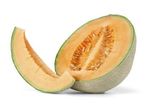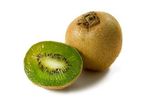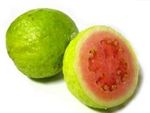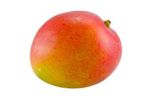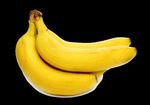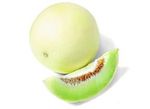JULY: MELONS - City of Kerman
←
→
Page content transcription
If your browser does not render page correctly, please read the page content below
JULY: MELONS
Melons mean summer! And, they mean nutrition: they are packed with vitamins A and C, as well as potassium, fiber,
and water! Seek these yummy summer treats, cantaloupes, honeydews, and watermelons, at your farmer’s market,
grocery, or home garden!
CHECK OUT THE VARIETIES OF HEALTHY MELONS DESCRIBED BELOW!
The cantaloupe is the most popular melon in the United States, and is grown and
eaten all over the world! Melons came originally from the Orient, via Armenia, to
Europe and then to America. Some research has shown that the beta-carotene in
many cantaloupes beats the amount found in bright orange oranges! It is usually
eaten as a fresh fruit, or in a salad, but also is served as a dessert with custard or ice
cream.
Be sure to choose a cantaloupe with large webbing or netting on the skin, that is
yellow/orange in color, and slightly soft on the stem end (firm elsewhere). It should
also have a good cantaloupe smell on the stem end, and the scar at the stem end
should be a smooth and well-rounded cavity. Often, melons will have a decidedly
bleached side that rested on the soil - this does not affect the quality of the melon.
The watermelon is a summertime favorite! Rich in vitamins A and C, fiber, and water,
watermelon was widespread throughout Africa, and, by the 1600s, made its way to
Great Britain, Spain, China and beyond. Watermelon arrived in North America
courtesy of European colonists. It grows on a vine-like, flowering plant throughout
the world. Good-quality watermelon will be firm, evenly-shaped, heavy for its size
and have a deep-pitched tone when slapped with an open palm. Yellow skin on one
side of the melon is where the fruit contacted the ground and does not affect quality.
Honeydew melon is a variety of Muskmelon that originated in France and is
considered the sweetest of all melon. “Honeydew” actually is the American name for
the cultivar “White Antibes,” which has been grown for many years in southern
France and Algeria. It's also a good source of vitamin B6, folate and potassium, and a
very good source of vitamin C. The honeydew was revered as a sacred food by the
ancient Egyptians. Napoleon and Pope John Paul II both considered honeydew
melons their favorite fruit!Melons Tips Melons Recipes!
Combine melon with reduced sugar lemonade in a Cantaloupe Ice Pops
blender for a refreshing summer drink! Makes 12 servings
Hollow out a melon and fill with sherbet, cottage
cheese, or vanilla ice cream. Ingredients
4 cups cubed cantaloupe
Top cubes of melon with fruit yogurt and sprinkle ¼ cup sugar
with granola for a yummy one-dish breakfast! 1 T chopped mint
Serve melons slightly chilled; if they are too cold, ½ tsp grated lemon peel (optional)
you’ll miss their full fragrance (except for 12 small paper cups
watermelon, that one can be ice cold!). 12 plastic spoons
Directions
Melons Recipe! In a blender, combine the cantaloupe, sugar, lemon juice,
mint, and lemon juice; cover and blend till smooth. Pour ¼
Cantaloupe Salsa cup mixture into each paper cup. Freeze until thick and
slushy, about 1 hour. Insert one spoon, handle up, into
Ingredients each cup of frozen mixture. Freeze till solid (2 hours). Peel
½ cantaloupe, seeds and rind removed, chopped into paper cup off each treat and enjoy! (Source: California
very small cubes Cooperative Extension)
¼ cup red bell pepper, finely diced
¼ cup cilantro, finely chopped
3 T scallions, finely chopped Melon Compote
Juice of 1 lime (or 3 T lime juice) Makes 4 (3/4-cup servings)
Directions Ingredients
Put all ingredients in a bowl. Stir. Add pinch of salt and 1 1/2 cups cantaloupe, cubed
pepper. Chill. Serve with grilled chicken, fish, or baked 1 1/2 cups watermelon, cubed
tortilla chips. (Source: Utah State University 1/2 cup sweetened apple juice
Cooperative Extension) 1 tablespoon mint, finely chopped
1/2 teaspoon orange rind, grated (optional)
2 kiwi fruits, peeled and sliced
Combine cantaloupe and watermelon cubes in a medium
bowl. Mix apple juice, mint, and orange rind separately.
Pour over melon cubes. Toss. Cover and chill 30 minutes.
Add kiwi fruit and toss. Garnish with fresh mint leaves, if
desired. (Source: U of Maine Cooperative Extension)JULY: TROPICAL FRUITS
Tropical fruits come in many colors, sizes, and varieties including papaya, pineapple, mango, guava, bananas, and
kiwi. Most tropical fruits are eaten raw and contain lots of fiber, as well as vitamins A and C, and water. More fresh
mangoes are eaten every day than any other fruit in the world!
CHECK OUT THE VARIETIES OF HEALTHY TROPICAL FRUITS DESCRIBED BELOW!
The papaya is a melon like fruit with yellow-orange flesh enclosed in a thin skin that varies in
color from green to orange to rose. Papayas are a good source of vitamin A and C. Look for
papayas that are partly or completely yellow in color, depending on variety, that give slightly to
pressure, but are not soft at the stem-end. Avoid papayas that are bruised, shriveled, or have
soft areas. Papayas that are hard and green are immature and will not ripen properly. Uncut
papayas have no smell. Papayas that are cut should smell sweet, not bad or fermented.
The word "Pineapple," is derived from the word pina, which was used to describe a pine cone
by the Spanish. Today, in the US the pineapple is sold fresh or canned. It is most widely used
tropical canned fruit. Select pineapples with a nice fragrant smell. It is really ripe if you can
easily pull one of the leaves out of the top. Store at room temperature for 1-2 days before
serving to allow the pineapple to become softer and sweeter.
Most of the mangos sold in the US are imported from Mexico, Haiti, the Caribbean and South
America. There more than 1,000 different varieties of mangos throughout the world. All
varieties of mangos have a rich tropical flavor when ripe. Choose firm plump mangos that give
slightly when pressure is applied. Avoid those with bruised or dry and shriveled skin. A ripe
mango will have a full, fruity aroma emitting from the stem end. Mangos can be considered
ready to eat when slightly soft to the touch and yield to gentle pressure. The best-flavored fruit
have a yellow tinge when ripe; however, color may be red, yellow, orange, green, or any
combination.
Kiwifruit history began in the Yang-tse river valley in China, where it was called "Yangtao." The
Yangtao was considered a delicacy by the court of the great Khans who cherished its delicious
flavor and emerald-green color. The first kiwi was shipped to the United States in 1962, from
New Zealand. It was renamed Kiwifruit after New Zealand’s national bird the "kiwi." Most
kiwifruit imported to the US comes from Chile and New Zealand. Kiwifruit is available year-
round. Select kiwifruit with no bruises or soft spots. Avoid fruits with wrinkles or signs of
exterior damage. Buy firm kiwifruit and let them ripen at home for a juicier flavor. A kiwifruit is
ripe when plump and slightly soft to the touch with a fragrant smell. The seeds of the kiwifruit
are a great source of fiber!The place of origin of the guava is uncertain, but it is believed to be an area extending from
southern Mexico into or through Central America. It has been spread by man, birds and other
animals to all warm areas of tropical America and in the West Indies. Varieties differ widely in
flavor and seediness. The better varieties are soft when ripe, creamy in texture with a rind that
softens to be fully edible. The flesh may be white, pink, yellow, or red.
Bananas are the most popular fresh fruit in the US. They have a peel that comes off easily,
bananas ripen after they have been picked, there is a generous supply all year, and they are
inexpensive. Avoid bananas with brown spots that seem very soft. Select medium sized
bananas with a nice color, specific for the variety. Choose fruit that is firm and free of bruises.
Tropical Fruits Tips Tropical Fruits Recipes!
Papaya Boats – A Festive, Healthy Salad!
Combine kiwi slices, pineapple chunks, strawberry Makes 4 servings
halves, and banana slices for an easy fruit dessert.
Put all in a bowl, add a drizzle of orange juice Ingredients
concentrate, mix gently, and top with some vanilla 2 papayas, ripe 1
Greek yogurt. 1 small can (11 oz.) mandarin oranges, drained
When baking pork chops, consider laying a yummy 1 small banana, sliced
piece of pineapple on top to add some natural 1 kiwi, peeled and sliced
1 cup mixed blueberries and strawberries
sweetness.
1 cup nonfat Greek vanilla yogurt
Make a healthy banana smoothie by blending one
2 tbsp. honey
cup of banana slices, one cup of Greek yogurt, and a
2 tsp. chopped fresh mint
few cups of crushed ice. Blend all ingredients until
smooth, about two to three minutes, pour into Directions
glasses. Cut papayas in half lengthwise; scoop out seeds. Place
Throw a banana in your lunchbox or backpack for a oranges, banana, kiwi and berries in each papaya half.
quick snack with lots of fiber and potassium. Combine yogurt, honey and mint; mix well and spoon over
fruit before serving. Garnish with mint sprigs, if desired.
Kiwi Mango Salsa
Makes 2 servings
Ingredients
2 kiwis, diced
½ cup mango, chopped
2 tbsp. chopped cilantro
2 tsp. lime juice
1 tsp. minced chilies
Pinch of salt
Place diced kiwi in bowl and mix gently with other
ingredients. Top cooked chicken or fish with the kiwi
mango salsa.You can also read




